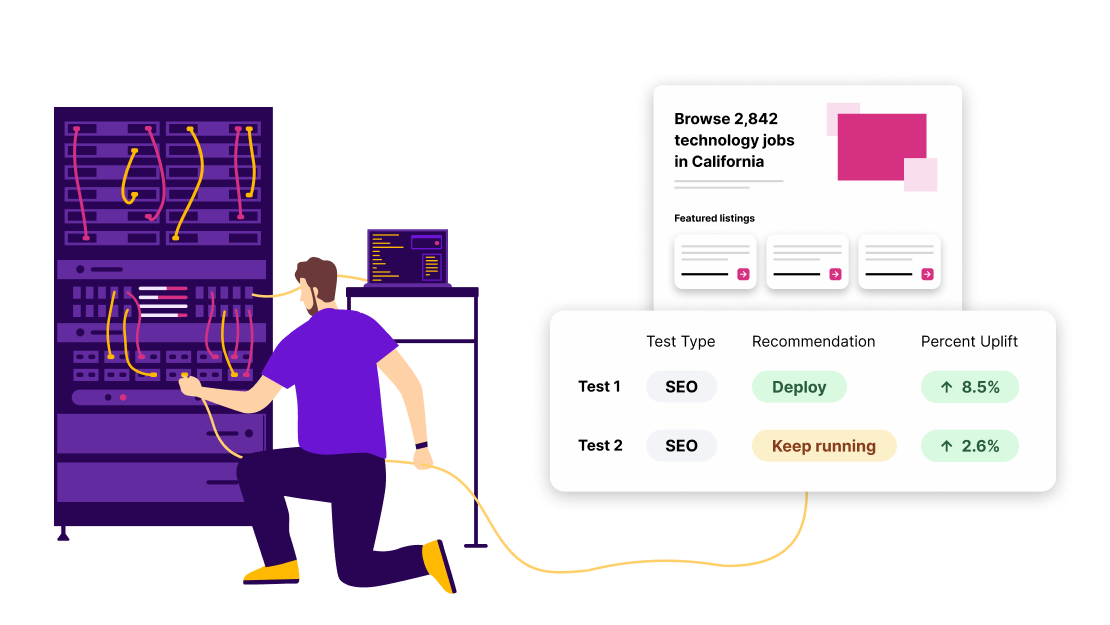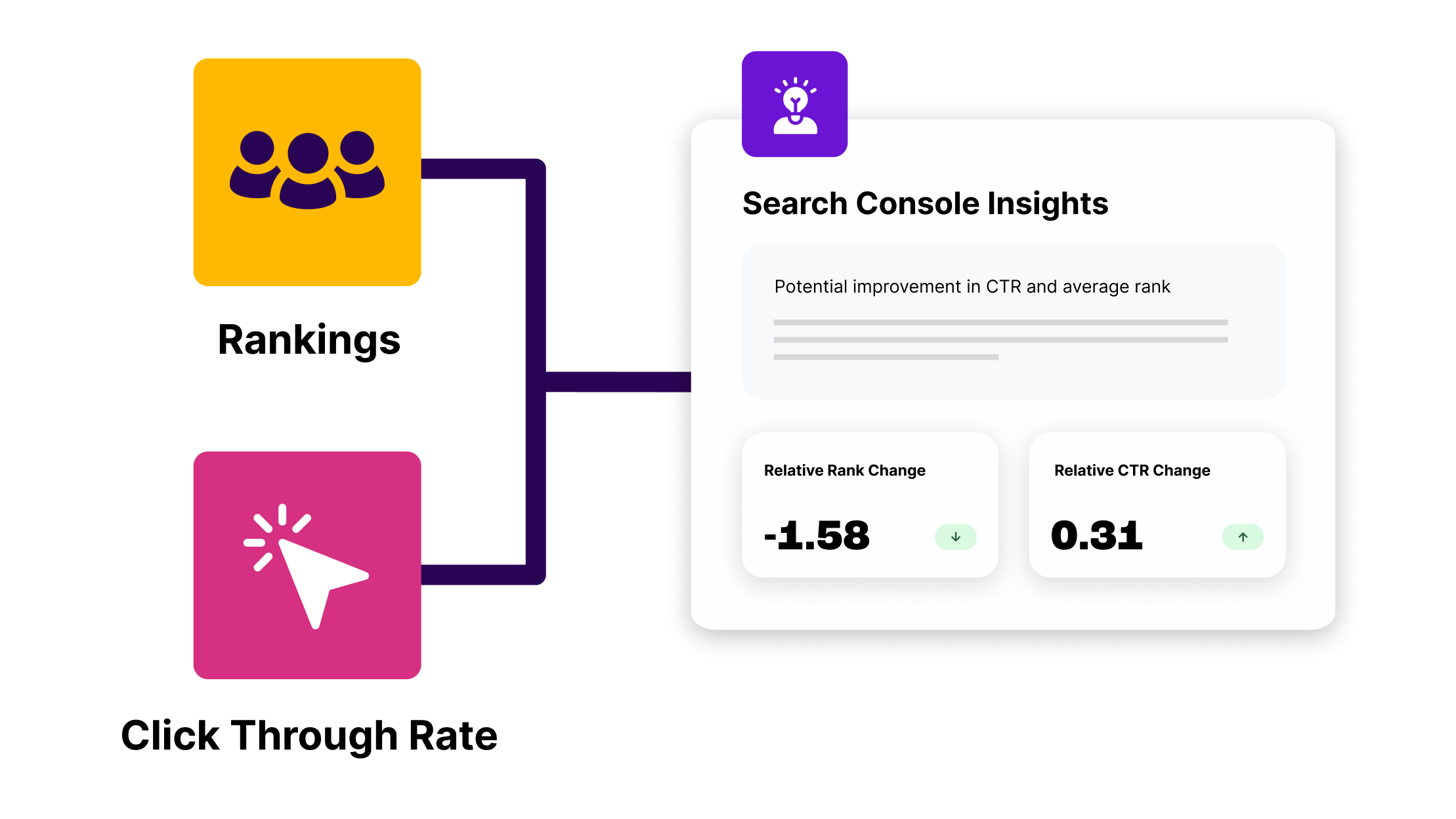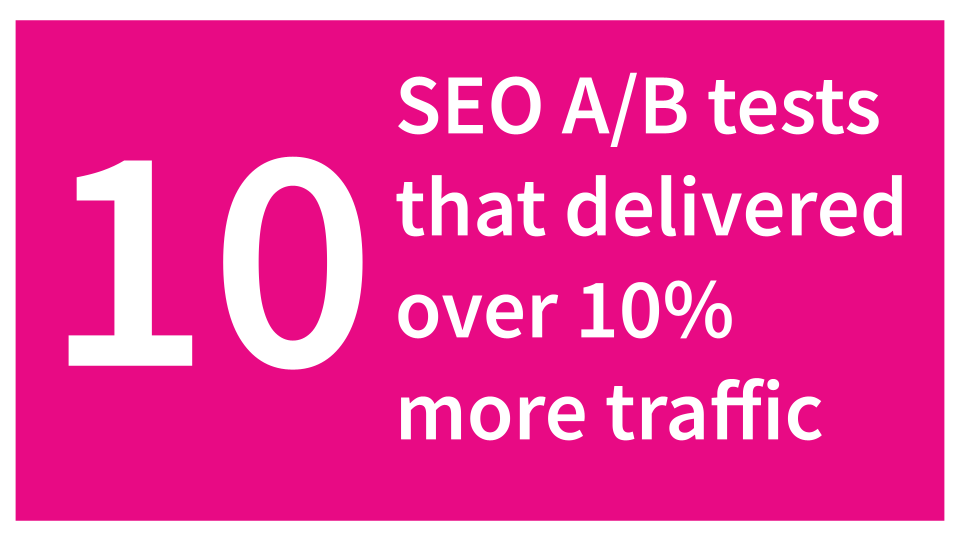Seventy-four percent of companies say converting website visitors into paying customers is their top marketing priority. Growing website traffic falls in second place, with a 57 percent share of the vote.
These figures indicate a clear focus on Search Engine Optimization (SEO) and Conversion Rate Optimization (CRO)— both of which are integral for increasing the success of your marketing efforts.
However, these two functions often clash within organizations.
SEO teams want to make changes that will bring in more traffic, and traditionally don’t pay enough interest in what users do once they land on the website. Conversely, Product or UX teams can be accused of caring too much about the look, feel, and functionality of a website without taking into account the impact on traffic.
This conflict is only exacerbated by the nature of CRO-only and SEO-only tests, which don’t measure the full impact one has on the other.
In this blog post, we’ll look at why this is and how you can overcome the conflict between SEO and product teams with full-funnel testing. This process allows you to test both SEO and CRO tactics at the same time and measure the relative impact of both. With this data, you can strike the ideal balance between SEO and CRO and get the most out of your website.
How do SEO and CRO tests work?
Let’s look at SEO first.
In SEO-only testing, we split pages into a control group and a variant group to compare performance. Without this, we would just be looking at a “before and after” picture, where any external influences could impact the result.
Next, we make a change to the variant pages and compare organic performance.
From this test, we can determine the SEO impact. But we still don’t know the impact on conversion rate.
Now, let’s look at CRO-only testing.
To run a CRO experiment, we assign cookies to web users at random and show them a landing page design based on that cookie. From then on, they’ll always see that version of the webpage they navigate the website.
Using this conversion rate-only tactic, we can measure the impact on conversion rate, but we don’t know the impact on traffic. This is because there is only one Googlebot (which does not accept cookies). So Google will always see the same version of every page, regardless of how we segment users.
As we can see - the trouble with just using either SEO testing or CRO testing is that we don’t get insights into how they impact each other.
Of course, not all changes to your website will cause conflicting results. For instance, some SEO changes, such as meta-information modifications, carry minimal risk to conversion rates. These aren’t visible to users on the page.
Similarly, certain CRO changes don’t impact organic search performance. Actions to non-indexed pages, such as checkout processes or login areas, are not seen by Google and won't affect rankings.
However, everything else has a potential impact on both SEO and CRO.
This chart shows the search impact of a suggested CRO change on SEO, which decreased organic traffic by 25 percent:
Introducing: Full-funnel testing
Full-funnel testing lets you measure the relative impact of SEO and CRO changes at the same time.
With this method, your SEO team can test the changes that they believe will bring more users to the website without impacting conversion rates. Meanwhile, your product team can make effective UX changes while better understanding the impact on organic search traffic.
Without full-funnel testing, this relationship is impossible to determine.
How does it work?
With full-funnel testing, we split pages into a control group and a variant group, just as in the pure SEO testing scenario we discussed earlier.
Once we have gathered enough data to conclude the SEO test, we transition to a CRO test.
This time, each user is bucketed randomly regardless of which page they land on within the site section. While this CRO test is running, we are able to layer the conversion rate impact on top of the already-measured SEO impact. This allows us to therefore track the combined impact on conversions of both tests.
Using the same site section means we have confidence in the impact of both tests on that group of pages, and we can be sure that the change we are planning to roll out is the same in both tests. You can see the relative impact on both SEO and CRO and use this data to inform your future strategies.
Let’s bring this to life
Imagine your CRO-only test results tell you that you can increase click-through rates by placing a call-to-action (CTA) large, bold, and above the fold. Meanwhile, your SEO-only test results may indicate that it’s better to use this valuable space to provide more relevant content for your visitors. Which do you choose? It’s impossible to decide without the right data.
This is what full-funnel testing offers.
With visibility into SEO and CRO impact, you can make an informed decision on whether to change your CTA. Simply analyze your full-funnel test result and weigh up the benefit to conversions against the impact (if there is one) on traffic.
And it’s not only about trade-offs or deciding whether to prioritize SEO or CRO. It’s often possible to iterate and find versions of winning tests that have (at worst) a neutral impact on the other metric - giving you the best of both worlds.
And this is one of the many reasons SearchPilot is good for SEO and good for business.
The wider benefits of aligning SEO and CRO
Full-funnel testing is more than a campaign strategy — it’s a shift in how you prioritize and analyze your marketing efforts. With newly-aligned tests, backed by proven data, your business can:
Surpass your competition and gain market share
Without full-funnel testing, your competitors will continue to make SEO and CRO changes with no visibility on how one impacts the other. Meanwhile, the insights you gain from full funnel testing will help you make website changes that improve both traffic and conversions at the same time.
This agility gives you the edge needed to stay ahead of your competition and increase your market share.
Encourage collaboration between SEO and CRO teams
As we discussed at the beginning of this blog post - SEO and CRO teams are often in conflict with each other. The capabilities of full-funnel testing, however, allow for more effective collaboration and understanding between these two functions. And when multiple teams are pulling in the same direction, you’ll find success faster.
Demonstrate the value of marketing
With proven data to reinforce your SEO and CRO tests, your teams can make more confident changes without fear of wasting resources or money. This data also offers you a stronger thread of accountability; you can strip away any guesswork and pinpoint which tests garner the best results.
Prove ROI and generate more sales
Most importantly, full-funnel testing gives you a complete picture of how SEO and CRO changes contribute to your bottom line. With a definitive ROI, your marketing teams can launch strategies that generate more customers, sales, and revenue for your business.
Are you eager to bring your SEO and CRO teams together and see full-funnel testing in action?
To dig deeper into how SearchPilot can accomplish this for you, contact us today for a full demo.



